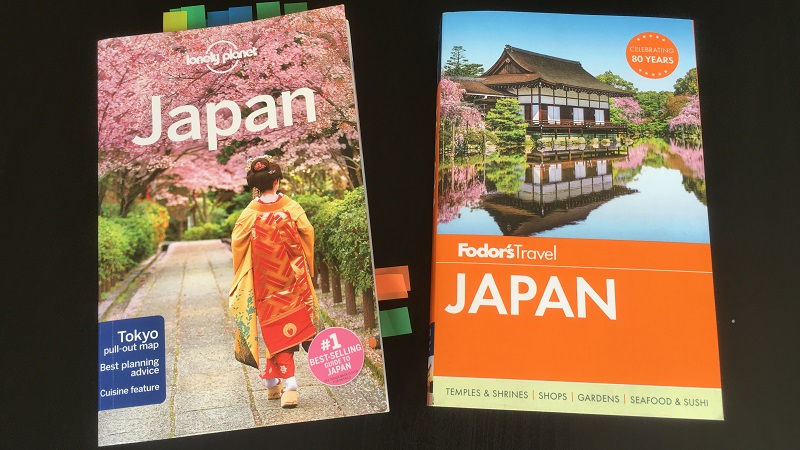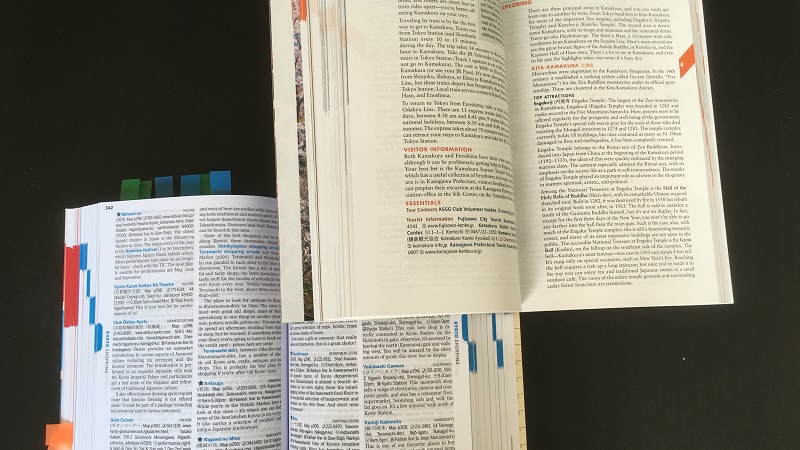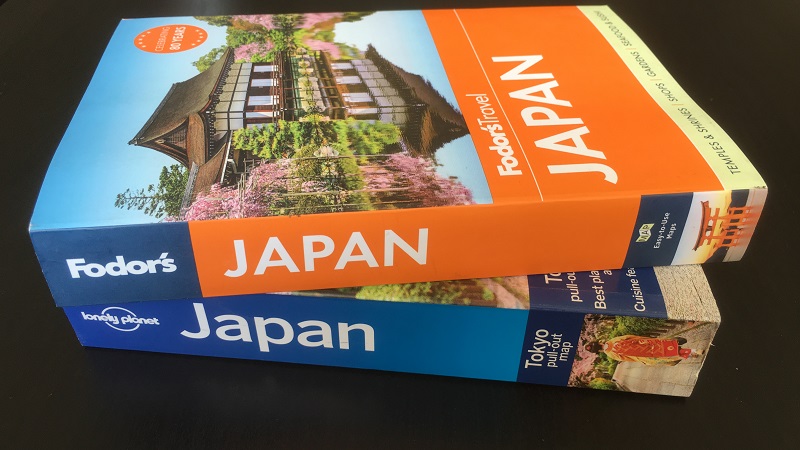Smartphones, Wi-Fi and GPS have made travelling easier, but a physical travel guide is always a smart investment when trotting the globe. Both Lonely Planet and Fodor’s have been around for decades, but it’s time to decide which guidebook deserves that coveted space in your travel bag.
The Contenders

There’s just something about not having to rely on internet service or battery life that makes guidebooks an essential part of exploring new destinations. With one book you can navigate, learn the culture and find hidden hotspots no matter where you are. In fact, despite all the great apps and online travel guides out there, guidebook sales are up and they’re making a serious comeback. There are a lot of options for you to choose from, but we’re comparing two of the most popular and all-inclusive guidebook series available:
- Lonely Planet: In just over 40 years, Lonely Planet has printed over 120 million books and become the world’s most successful travel publisher. They have published around 500 titles that cover 195 countries, and they hire a combination of travel writers and local writers when creating or updating each one. Lonely Planet travel guides cost between $15-$30.
- Fodor’s Travel: Fodor’s has been dishing out travel advice and publishing guidebooks for 80 years. They prefer to hire local writers based in each destination for their guidebooks instead of travel writers. In total, they have published over 300 travel guides that cover more than 7500 destinations around the globe. Fodor’s travel guides cost between $25-$35.
Lonely Planet guides are updated with new editions every two years or so. Fodor’s guides are also updated every two to three years depending on the location. Generally, the more popular the location, the more often the guide will be updated.
Layout and Contents: Lonely Planet Dives Into Planning While Fodor’s Primes You On the Culture

In terms of layout, Lonely Planet guides use double-columned pages with small print. It can be hard to read if your eyes are tired or if you have trouble reading without glasses. Fodor’s guides, however, use larger print and keep their pages single-columned. This makes their guides much easier to read, but that comes at the cost of having less information overall when compared to the encyclopedic amounts of data crammed into every page of a Lonely Planet guide.
Lonely Planet organises their guidebooks into four major sections:
- Plan Your Trip: This section covers all the vital information you need to make your trip a reality. It includes a quick cultural and etiquette primer, a map of the country, popular things to see and do, a month-by-month calendar of major cultural events, example itineraries, ways to save money on your trip, and tips for travelling with children. This section also includes sections dedicated to first time travellers to the country, as well as a section highlighting what’s new in the country for those who have been before (something you won’t find in Fodor’s guides).
- On the Road: This section is the real meat of the guidebook, and it covers each individual city/area of the country and breaks it all down. For each part of the city, the book highlights sights, activities, festivals, events, nightlife, entertainment, shopping, where to eat, and where to sleep. Each individual listing has an address, phone number, web site (if available), pricing, and a very brief description. There are also maps for certain areas.
- Understand: If you want to get a more thorough understanding of where you’re travelling, the Understand section covers everything you need to know: current affairs, history, the people, cuisine, arts, architecture, traditional accommodations, sports, and natural environment. The Plan Your Trip section has a quick cultural primer, but the Understand section is more of a course on the country and the people who live there.
- Survival Guide: As the name implies, the Survival Guide section is designed to be a quick reference to anything you need to know about the country. Everything from transport to medical care to electricity sockets to toilets are covered. There’s also a small section dedicated to important phrases that can help you if you’re lost or in need of something.
The Fodor’s guides cover a lot of the same material, as you’d expect, but organise things a bit differently. Their guides have five sections that go like this:
- Experience [Country/Region]: The Experience section is similar to Lonely Planet’s Planning section. It covers current affairs, top attractions and experiences, etiquette, money-saving tips, and some planning suggestions, but opts for a “less is more” approach as opposed to Lonely Planet’s “cram as much information as possible onto each page” style. This section is also filled with a ton of full colour photos (something the Lonely Planet guides are definitely lacking.)
- A [Country/Region] Primer: This is equivalent to the Understand section in the Lonely Planet guides, complete with detailed information on local arts, pop culture, sports, current affairs, history, cuisine, natural environment, and even religion in this section. Once again, there are plenty of pictures in this section to help you visualise the culture.
- City/Area Chapters: Like Lonely Planet, these mini guides for each city are the most information-heavy parts of Fodor’s books. They include information for all the sights, activities, festivals, events, nightlife, entertainment, shopping, restaurants, and hotels. And each individual listing has an address, phone number, web site (if available), pricing, and a description in addition to maps for certain areas.
- Understanding [Country/Region]: This is often a very brief section that has a few pages to help you further understand the culture, and it also contains a collection of essential phrases and reference material for deciphering menu text.
- Travel Smart: Tips for transportation, accommodations, electricity, healthcare, emergencies, and safety. It’s a less-exhaustive version of the Survival Guide section in the Lonely Planet books.
All in all, both books cover a lot of the same material, but with very different approaches. Fodor’s front loads their guides with in-depth cultural information and photos, introducing you to the region before it starts throwing information on how to get there at you. Lonely Planet does the opposite, and assumes you already know a little about the country’s culture. It saves the cultural rundown reading for later as a bonus, which is nice if you just want to get there first and ask questions later.
Appearance and Book Quality: Both Look Great, Are Easy to Handle, and Can Take a Beating

In terms of appearance, both guidebook series print in paperback and look remarkably similar in their current printing. Even their bindings follow the same visual pattern of “travel guide company name, country, a mention of a pull-out map, photo of location,” and both their covers use the same shade of blue. If you weren’t paying attention, you could easily mistake them for each other as you walk by them in the book store.
Fodor’s definitely has a leg up on Lonely Planet when it comes to overall quality, though. The current editions of their books are printed in full colour on glossy, textbook-like paper that looks like it would hold up to even the roughest of trips. Lonely Planet’s current printing uses thinner, newspaper-like paper for its pages that feel like they could tear easily. Despite their different page materials, both books have sturdy covers and bindings that can take a beating and survive being crammed into a small backpack with other gear. Both books can also be used one-handed fairly easily as well, but not for too long since they tend to get heavy. Lonely Planet books tend to be a bit thicker than their Fodor’s counterparts, but their weight is usually pretty similar because the newspaper-like pages are lighter.
Digital Versions and Mobile Apps: Both Can Be Found On Your Favourite Devices
If you don’t want to travel with a physical book (though I recommend it), Lonely Planet guides come in EPUB, MOBI, and PDF formats for most ebook readers and tablets (in colour where available). All of their guides are available on Nook, Amazon Kindle, and most of them are free to Kindle Unlimited subscribers. Fodor’s guidebooks are available in ebook format as well (also in colour where available), but can only be purchased on Nook or Amazon Kindle.
The Guides by Lonely Planet app (shown in the video above) is free to download and use on iOS and Android devices, and includes information on 38 different cities around the world. It also features offline maps and navigation, sights and destinations bookmarking, and more.
The app is a great companion to your guidebooks, no matter which one you go with. The same can be said for Fodor’s City Guides app, which offers guides for 22 different cities across the globe. The guides include recommendations from Fodor’s staff of local writers, maps, and the ability to filter your destination searches by price range and category. Unfortunately, the Fodor’s City Guides app is only available on iOS devices.
Conclusion
Neither of these will do you wrong when you travel, but each is better suited for a certain type of traveller. Lonely Planet throws more information at you than you’ll ever need, which is a good thing because you’re getting a ton of bang for your buck. Even though Lonely Planet guides can be more expensive than Fodor’s guides, they’re still worth every penny. But that massive amount of information also means you have to comb through it all yourself to plan your trip. It tells you places you should go to, but it doesn’t always show you. So think of it more as a list of suggestions and not an essay exploring the wonders of various corners of the world. If you’re ok with that, Lonely Planet is the best pick, period.
Fodor’s guides, on the other hand, are a more curated experience and better suited for the “show me the way” type traveller. And they’re a lot more fun to actually read. Their books have less information overall when compared to the exhaustive amount found in the Lonely Planet guides, but it’s information you can live without (or could find somewhere online). By narrowing their focus, Fodor’s manages to provide the essential information you need while also amping you up with photos and descriptions that aren’t “all work and no play.” As you read through a Fodor’s guide, you can see your future trip unfolding in your mind. That said, Fodor’s guides hold your hand a bit more, so it feels less like an adventure and more like a planned vacation. That’s perfect for some travellers, but for others (like me), it might make the trip feel a bit too touristy.
If I were to sum these guides up to a friend, I’d say both books are like a box of LEGO bricks. No matter what, you have every piece you need to construct a great trip. The only difference is the Fodor’s box comes with an instruction booklet, and Lonely Planet’s doesn’t. Which way do you like to play?

Comments
One response to “Travel Guidebook Showdown: Lonely Planet Vs. Fodor’s Travel”
Fodor just makes me think “Fold the door”